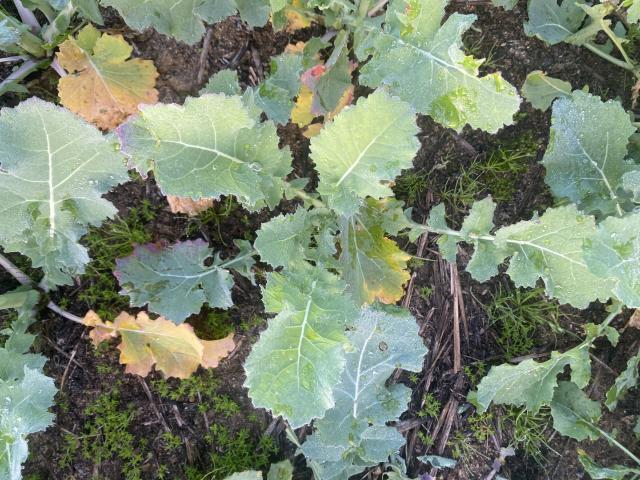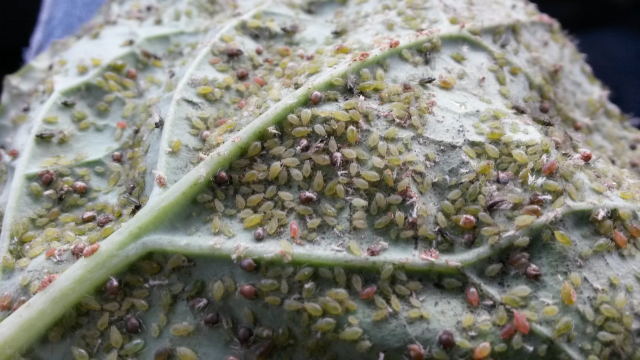Aphid and Turnip Yellows Virus Management: Research Highlights
At a glance
- A four-year project “Targeted, proactive and effective management of green peach aphid, turnip yellows virus and insecticide resistance” has been completed..
- A Turnip yellows virus (TuYV) early warning system was tested for its ability to accurately detect risk of TuYV epidemics and mitigate their impact.
- Promising sources of resistance to TuYV were identified in Brassica napus and B. oleracea lines. Pre-breeding resources were developed for two such lines.
- Green peach aphids (GPA) were found to have developed metabolic resistance to neonicotinoids and is likely impacting the efficacy of neonicotinoid seed treatments.
- Preliminary experiments indicated that abiotic factors such as drought stress, soil type and presence of TuYV in aphids could also be affecting the efficacy of neonicotinoid seed treatments.
- Neither a neonicotinoid seed treatment, nor a pre-emptive foliar insecticide application was found to significantly suppress TuYV spread under field conditions.
- Partial resistance to TuYV, found in the canola variety ATR Stingray, was found to be highly effective in suppressing TuYV spread under field conditions.
Turnip yellows virus is the Australia's most widespread and economically damaging virus of canola with epidemics occurring regularly. In recent growing seasons, Australia has experienced severe TuYV epidemics across vast canola production areas causing considerable losses. Field experiments in Western Australia (WA) have shown up to 46% canola seed losses, oil content decreases and erucic acid increases when seedlings were infected.
Plants infected with TuYV may exhibit stunted growth and lower leaf reddening or yellowing. However, symptomless infection can often occur, potentially mistaken for nutrient deficiencies, other abiotic stresses or going completely unnoticed.
TuYV is transmitted in canola in canola primarily by Myzus persicae, otherwise known as the Green peach aphid (GPA). These aphids spread TuYV from infected weed and volunteer host plants that survive over summer. The GPA also stands out as the insect with the highest level of resistance to insecticides globally, leaving limited chemical options available to control this pest.
A collaborative four-year project between Cesar Australia and the Department of Primary Industries and Regional Development (DPIRD), which aimed to better understand the efficacy of current and new tools for the management of TuYV and GPA, has just been completed. Dr. Ben Congdon, a research scientist from DPIRD, was involved in the project and highlights the major outcomes in this newsletter.
Field validation of the TuYV early warning system
The GPA can rapidly spread TuYV through large areas of canola crops. Due to the speed at which GPA can spread TuYV, it is possible for insecticide applications aimed at preventing such spread to be applied too late.
In a previous Royalties for Regions investment, DPIRD developed an early warning system for identifying migrating aphids carrying TuYV. This research utilised yellow sticky traps to capture aphids and a rapid and sensitive virus detection technique known as loop-mediated isothermal amplification (LAMP) to detect TuYV. This system detects TuYV in migrating aphid vectors before a virus epidemic develops in the crop. Early warning would allow the growers an opportunity to proactively intervene with an insecticide application before yield damage can occur.
Dr Congdon, in collaboration with Cesar Australia and many agronomists and consultants, coordinated the ground truthing of the early warning system (EWS). Over four seasons and three states, 164 paddocks were monitored to determine if the early warning system effectively reduced the spread of TuYV. Whenever a TuYV infected GPA was detected, the grower was promptly alerted, and provided with additional information about the virus and the likely implications of the detection. Testing virus infection levels in the crop indicated the early warning system provided meaningful results at most of the sites. The most significant value of the EWS in this study was its ability to give the grower the confidence not to spray when aphids were present, but the virus was not. This may have reduced the amount of chemical used reducing the costs to the grower, the carbon emissions associated with growing the crop and the impact of insecticide on non-target organisms.
| Metric | 2019 | 2020 | 2021 | 2022 | Total |
| Total crops monitored | 15 | 43 | 54 | 52 | 164 |
| WA | 15 | 30 | 39 | 26 | 110 |
| VIC/NSW | 0 | 13 | 15 | 26 | 54 |
| Traps deployed | 112 | 461 | 727 | 499 | 1799 |
| Aphids caught and tested | 582 | 5145 | 3248 | 3597 | 12572 |
| Early warnings sent | 0 | 21 | 40 | 38 | 99 |
| Crops with subsequent TuYV infection | 0 | 15 | 20 | 12 | 47 |
Abiotic factors influencing the efficacy of insecticides
Neonicotinoid seed treatments, containing compounds such as imidacloprid, thiamethoxam and clothianidin, have been considered critical in effectively managing TuYV by protecting vulnerable canola seedlings from GPA colonisation. However, Cesar Australia has found that metabolic resistance caused by the over expression of the cytochrome P450 gene, CYP6CY3, is resulting in widespread resistance of GPA to neonicotinoid seed treatments in varying levels across Australia. Under semi-field trials, this resistance significantly compromised the effectiveness of neonicotinoid seed treatments Gaucho® and Cruiser® Opti which has serious implications for their role in combatting TuYV. For more information refer to the prior April issue of Protecting WA Crops where
Preliminary research as part of the project indicates that besides metabolic resistance, abiotic factors such as soil type, drought stress and the presence of TuYV, could also affect neonicotinoid resistance in GPA. However, further research is required to confirm these early findings.
Soil Type
Early research conducted by DPIRD and Cesar Australia compared the efficacy of neonicotinoid seed treatments on varying soil types: sand, sandy loam soil (sterilised and unsterilised), and at two different ratios of sand to loam (1:2 and 2:1) and potting mix. It was found in the glasshouse that the seed treatment effectively controlled aphids for up to 6 weeks after emergence in sand and loam:sand treatments. However, it was less effective when plants were grown in potting mix. In the Cesar Australia trial, soil sterilisation had no impact, suggesting that soil organic matter was a key inhibitory factor in seed treatment efficacy. This result could indicate that highorganic matter levels in paddocks may negatively impact seed treatments. Future research should test this under field conditions.
Drought stress
A preliminary glasshouse experiment was conducted in which aphids were added to canola plants with or without simulated drought stress. Plants in the drought stressed treatment were visibly wilting and a reduction in biomass compared to well-watered plants. In this experiment the seed treatment was significantly more effective at controlling aphid numbers under drought conditions than under well-watered conditions. This could possibly be due to an increase in the concentration of the active ingredient in the plant however more rigorous scientific research is required for confirmation.
Virus infection
A replicated glasshouse experiment indicated that the presence of TuYV in GPA could enhance their survival on seedlings grown from neonicotinoid treated seed. This experiment also showed that 8-week-old canola plants were more resistant to TuYV infection than 2-, 4- and 6-week old plants.
Assessing management options – pre-emptive insecticide application
With GPA resistance to neonicotinoid seed treatments becoming an increasing issue, new management options are required to control GPA and subsequent TuYV infections in canola. Foliar insecticide applications are currently the only post sowing control option. However, these are most commonly used after an epidemic level of spread has occurred, when GPA numbers are high, and they are less effective. DPIRD trials investigated the option of a pre-emptive insecticide application in plot trials. The single insecticide application significantly suppressed aphid numbers during the early stages of aphid colonisation indicating some residual control. However, these applications were mostly insufficient to significantly suppress virus infection.
Identifying and testing sources of resistance
Three separate field trials investigated the effectiveness of the partially TuYV resistant ATR Stingray compared to the susceptible ATR Bonito. Stingray had significantly lower levels of TuYV infection in all trials. When yield measurements were taken at Muresk in 2022, the inherently lower-yielding ATR Stingray outyielded ATR Bonito.
Promising sources of TuYV resistance were identified in different canola lines, and several were stronger than Stingray under glasshouse conditions. Given the performance of Stingray to resist TuYV infection under field conditions, it is likely these resistance sources could offer even stronger protection from TuYV. Two lines, SWU5 and SWU3, are currently being analysed in order to develop pre-breeding tools for the canola industry.
The research results on pre-emptive insecticide applications and TuYV resistance are discussed in further detail in the April issue of Protecting WA Crops.
For more information on GPA and TuYV refer to DPIRD’s Turnip Yellows virus in canola: diagnosis and management webpage or Protecting WA Crops newsletter issue 29, April 2023


